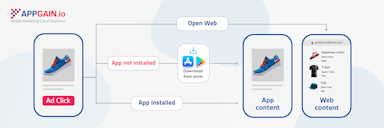Using a mobile is an essential part for your customer especially when they use it to advertise, promote or sell a product. Mobile marketing is a multi-channel, digital marketing strategy aimed at reaching a target audience on their smartphones, tablets, and other mobile devices, via websites, email, SMS and MMS, social media, and apps.
There are some important steps can help you define the experiences that customers go through when interacting with your company or brand and define customer behavior patterns, motivation, and goals as well. Moreover, it can help you achieve your aims and consider mobile marketing as one of the essential parts of your marketing strategy overall.
1. CONSIDER YOUR AUDIENCE
Take into consideration what the user wants, maybe a webinar or other marketing activities, and always take care of your marketing channels.
For example, when your persona is a young woman who regularly shops three times a week on the mobile application might be a good example of using in-app promotions. Another example, when your persona is an old man who has downloaded only five apps on his mobile might be a good example of using push notifications.
Recognizing these next different steps is very important, and these steps are the best way to engage with your audience.
Step 1: Create Mobile Marketing Buyer Personas:
Understanding your audience is the first step to any marketing strategy. Personas are simply fictional representations of your various types of customers and consider customer demographics, behavior patterns, motivation, and goals.
Customer persona can be created through research, surveys, and interviews of your perfect customer. That includes a mix of customers both good and bad fits for your app to make sure who to target, and who no to target.
Creating your customer persona:
1) Creating your persona’s identity:
- A) Give your persona a name that you feel represents your persona’s character. Also fill in some basic details about their background, hobbies, and education.
- B) Fill in their demographic details such as gender, age range, location, etc.
2) What are your persona’s motivations?
- A) A primary goal for using your application and secondary goal if there is one.
- B) How your mobile app solves the challenges, eases their pains and remove their disturbances.
3) Give your persona some life:
- A) What are some real quotes in this person’s life take during interviews?
- B) Giving some reasons for not downloading your app. 4) Your marketing message:
- A) Tell people how to talk about your products or services with your persona.
- B) A more general elevator pitch that positions your solution in a way that resonates with your persona.
Step 2: Understand the customer lifecycle
It’s traditionally used to map the different stages a customer goes through from considering a product, service or solution to the actual buy and, at least as important, the post-purchase stages where customer retention, loyalty, and advocacy come in. It gets increasingly used in different business functions including marketing.
There are 5 stages of the customer lifecycle that will help you understand and improve your customer service:
- 1) Reach: Your content must be properly marketed in places where people in your market will find your information. This way they will become aware of your company’s existence.
- 2) Acquire: You have to understand your customer’s needs so you can provide a product or service they will want to purchase. Contact them directly with personalized communication to convert them into paying customers.
- 3) Develop: After the first purchase, keep in touch and build a relationship with your customer. Make sure that they are fully satisfied with their purchase.
- 4) Retain: As long as you are satisfying, they will become brand advocates. This will spread awareness within their social circles, and the cycle will come full cycle when you reach potential new customers due to your existing customers.
2. SET YOUR GOALS
The key to defining an effective strategy is first to decide what success looks like. Get the key stakeholders together to map your mobile marketing strategy. Identify goals by asking yourself some of these questions:
- What are we currently doing for mobile? This will define your starting point, and make sure everyone is on the same page as you begin.
- If you are already doing mobile marketing, how are those initiatives performing? This Conversation will identify what is already working, what is not, what is not being measured.
- What are your main objectives for including mobile marketing in your overall strategy? Discuss why you are considering mobile now, what conversation led up to this point, and what you expect.
- Who are your key audiences for mobile marketing? Talk about your customer personas in light of mobile usage updates and how usage is similar or different.
3. Establish KPIs
Just like your other marketing efforts, mobile marketing needs to be tested and optimized. Determine which realistic, measurable KPIs define your mobile campaign’s success. For example:
- Engagement: Provide mobile-friendly content for potential customers who are searching for information about your industry or product. Make sure your website is mobile-responsive to improve mobile SEO.
- Acquisition: Make sure lead nurturing emails are mobile-friendly with clear calls-to-action. Buttons in emails should be near the top of the message and be big enough to tap to facilitate click-throughs quickly. Then make it as easy as possible for someone to fill out a form on your mobile-optimized landing page.
- Customer Service: In a connected, social marketplace, customer service is very much a marketing opportunity. Allow your customers to easily reach you through any platform they want, including simple click-to-call buttons for smartphone users.
To identify the right KPIs for your mobile marketing campaign, ask yourself:
A) Do I want to increase conversions from email messages?
B) Am I trying to improve traffic to sales pages?
C) How important is it that I generate more qualified prospects?
D) Does our brand need to improve sales by converting more traffic on certain pages?
4. MOBILE MARKETING AS PART OF YOUR OVERALL MARKETING STRATEGY
Creating a mobile marketing strategy needs only to think about how it can be compatible with your other overall marketing initiatives. Engaging with customers by sending out them Emails through social channels, and other cross-channel communications.
Communication Frequency and Relevance
Emails are the tools you use most of the time to communicate with customers, so you need to make sure that all communications are sync and these Emails must notify your mobile strategy especially if you are engaging in mobile notifications.
Using your marketing automation platform and listen to how people engage on one channel and use that to build up your other channel.
As with any marketing channel, mobile sites and apps need to be measured by key performance indicators to determine the appropriate business objectives and decisions before they can be optimized to generate high levels of user engagement that increase sales.
These are some sample communication plan steps with a customer:
• Mobile application download
• An email thank you is sent
• A push notification is sent
• Website personalization offer based on persona and app usage
• A check-in email is sent
• Social campaign on new app features
• An email is sent based on app usage
• An in-app message is sent
• Personalized ad on Facebook using targeting
Mobile Marketing Calendar
The marketing calendar is the best way to determine what your costumers can get from other communications and where they can receive.
The things that you keep in your toolbox can help you in the success of your marketing goals. A primary and essential tool is the marketing calendar. A marketing calendar assists you in launching your marketing vehicles in a way that can drive you to your goal using a structured and thought-out manner so that nothing is forgotten. Your marketing calendar serves as your blueprint and identifies what messaging you will use and how and what channels you will use to distribute that message.
Consider including the following in your marketing calendar to ensure that you have a complete look at all your marketing efforts at a glance.
1) Advertising Campaigns
2) Events
3) Content Pieces
4) Public Relations / Media Relations
5) Social Media Campaigns
6) Email Marketing
7) Point of Purchase Displays or Signage Efforts
By doing this, you are able to build consistency in your planning. This helps in preventing marketing lapses that cause, the “feast and famine” effect that many businesses experience.
Still, got questions? Do not hesitate to reach out and Contact Us! Request Demo now.









